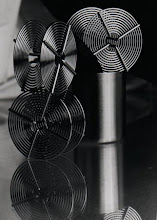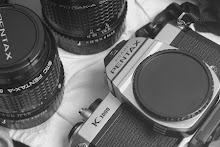Now, 68*F is a magic temperature in photography by design. But, it is not the only temperature at which we use photochemicals. For example, if we have three chemicals to mix, the manufacturer might recommend that the water used at one temperature during the mixing process, and at another temperature when the solution is actually used. Temperatures vary according to manufacturer’s recommendations for their products, but I think it is no accident that they commonly coincide with the temperatures found in most homes for cold, warm and hot water.
How does this affect us when we use the chemicals? Whether we are mixing up the solutions or using them to develop film or paper, we are using the solutions to promote a chemical reaction.
The chemical components in the solutions need room to move. The best way to give them more room to move is to raise the solution temperature. The best way to close the gap, so that they can be closer to the molecules they need to react with, is to lower the temperature. When we adjust the temperature at which we employ photochemical solution, on the molecular level and smaller, we are adjusting the amount of room energy has to move around in. Sometimes higher operating temperatures are good; sometimes colder is better.
Photochemical solutions are so sensitive to changes in temperature that a small change, a change of 3*F, will be enough to effect exposure times. Usually when we think of exposure times, we are considering the amount of time light is in contact with a photosensitive surface. But, key durations in photography also include the amount of time that chemical solutions like developers, stop baths and fixers are in contact with emulsions. Light is not the only way to bring energy to the image. The atoms in the molecules in the photochemical solutions are another.
Three degrees of variation in temperature may require a reduction or extension of processing times by about thirty seconds, commonly. Sometimes more, sometimes less, but look at the data sheet and see what it says.
For example, when processing, we will usually see a chart on the manufacturer’s label that will tell us, With this solution mixed at this ratio to water, bathe the emulsion for 5 minutes at a temperature of 68*. Now, sometimes there is also a range or window of acceptable temperatures, but sometimes that window might be small.
What They Told Us to Do, And What We Did
What is your developing temperature? Remember the thermometer? I recommend that you use it, at least sporadically, to check up on the temperature of your solutions as you process. While 68*F might be a common household temperature in Pennsylvania or Great Britain, both locations where big photo companies do a lot of their work, here in the Southeastern US, I have observed “comfortable room temperature” solutions that measured as high as 80*F.
If I apply solutions at 80*F for the durations listed for 68*F, I may get more active results. How much more active? The difference between 80*F and 68*F is 12*F. If I am using a solution that requires a 30 second change in time for every three degree increment in temperature differential, then a time that would be good for 68*F, but used at 80*F, would be as though I had added a minute and a half of exposure time.
A minute and a half may not seem like much normally; but, remember , these photographic emulsions are very sensitive. They are designed to be. We pay extra for those that are sensitive in the way we want; and, we’re getting our money’s worth.
A minute and a half difference in solution exposure duration may lead to a difference of at least one f/stop’s worth of light. A minute and a half too much might create the equivalent of a stop’s worth of overexposure. In the quest for the “perfect print”, this would never do.
Point here is: temperature counts. Particularly variations in temperature that carry the solution much beyond the manufacturer’s recommended operating range. Temperature counts because the chemical components in the photographic solutions are sensitive to the conditions that support or hamper their reactivity.
Temperature and Pressures Within a Solution
How does this relate back to Boyle’s Law? It may not seem apparent because when we use photochemicals, we don’t really try to change the pressure much in ways that we as people readily understand. When we think of pressurizing something, we usually think of arrangements like the pressure cooker used in the sea-level/high-altitude boiling water example. When we use photochemical solutions, we are, in deed, pressurizing them. We pressurize, or de-pressurize, them by adjusting their temperature.
The pressures that affect photo solutions are more than just the air pressure above. There are other pressures involved. Most of them, like air pressure, are invisible to our sight. Touch is the sense we most naturally use to detect pressure; and, the form of touch that tells us about the kinds of pressure are the sensations of heat or cold that are related to temperature.
Because of the chemicals involved, touching the solutions is often not good enough to help us judge the pressure for exposure times. Instead, we take the temperature of the solution with a thermometer.
When we take the temperature of the photo solution with a thermometer, we are actually getting a rough idea (a very rough idea) of how much pressure the atoms and molecules in the solution are putting on each other. The pressures that they feel by bumping into one another as components of a solution count. Did we give them enough room to move quickly? Are we crushing them into inactivity by freezing them? Did we give them too much room, and now they are too active, and eating up our print paper’s emulsion’s parts too fast?
When we take the temperature of the solution, we are learning about these incredibly small differences in pressure created by the parts of the solution bumping into each other.
Really, this is an amazing activity, if you think about it. Look at those photochemical solutions. The dissolved chemicals are commonly invisible. They look almost exactly like regular water. Sometimes there is a color change; sometimes we actually have a colloid, which is a very dense suspension of undissolved particles in a media like water; but most often, we cannot see the components of the solution as we could when they were undissolved crystals poured from the packet.
Observable or not, how are we as big, fat, clumsy human beings to measure something so small, yet so influential, as the pressures exerted on those chemicals? We take the temperature of the solution.
Thermometer Mechanisms We Ignore
How we actually take a temperature is also amazing. When we put a thermometer in a solution, if it is glass or metal encased, we are using a big, fat, bulk instrument to measure those tiny forces acting on the molecules in solution. Those molecules and atoms and subatomic parts all bang against the glass wall of the thermometer’s casing. The force of this very weak, almost indetectable banging pushes in on that hard glass enough to squeeze that quicksilver mercury up along the canal inside the thermometer. To read the thermometer, we simply wait a little while and observe how far up the channel the mercury has travelled. Crude marks on the side of the thermometer help us to understand the indicator’s progress (or regress).
For metal thermometers, like we see with dials on them, the process is similar. Engineers who supervised the construction of those metal thermometers knew that certain metals and their alloys expand or contract at a known rate when at a known mass, volume and ambient temperature. The engineers knew about the properties of the metals they used for building that thermometer.
When the indicator metal, the sensor itself, comes into contact with the solution, either directly or indirectly through a casing, the heat (or cold) transmitted energy through the metal; this subtle transmission of energy caused an expansion or contraction in that tiny volume of metal. This expanding or contracting metal was mechanically trapped inside the housing of the thermometer assembly in such a way as to push a needle across a dial. Often, the expansion or contraction that pushes the needle on an axle or a pivot is so subtle, that most designs magnify this pushing by adding in a spring of some kind.
The sensor of the metal darkroom thermometer expands or contracts. The sensor pushes against a part which pushes the needle in an arc. We look down upon the dial near the needle. We read what temperature the solution is. Amazing.
The common thermometer can tell us a great deal about the very small, puny, tiny, but influential pressures at work within a solution. Managing those pressures are important to us because when we are processing emulsions in a bath, we are exposing extremely sensitive chemical compounds to energy.
That exposure, whether to light or to chemical energy, is designed, in the end, to yield an image that we want to see.
That image, was traced on our paper as an illustration made with reflected light. Very delicate, and very beautiful; illustrations made with reflected light often exceed our abilities to draw with our hands. If we look closely, if we observe much at all, we will not only see the general impact our exposure had on the illustration process; but, we will also surely see some detail or effect that we may not have known was there, even if we thought we had carefully observed our subject and its surrounding environment.
A two-dimensional illustration drawn with bent, focused, light that slammed into delicate mixtures of chemicals; repeatedly edited by us, often without our care or our true understanding; an image that we made. That is our photograph.
Watch the temperature, and check up on it every so often.
# # #






No comments:
Post a Comment